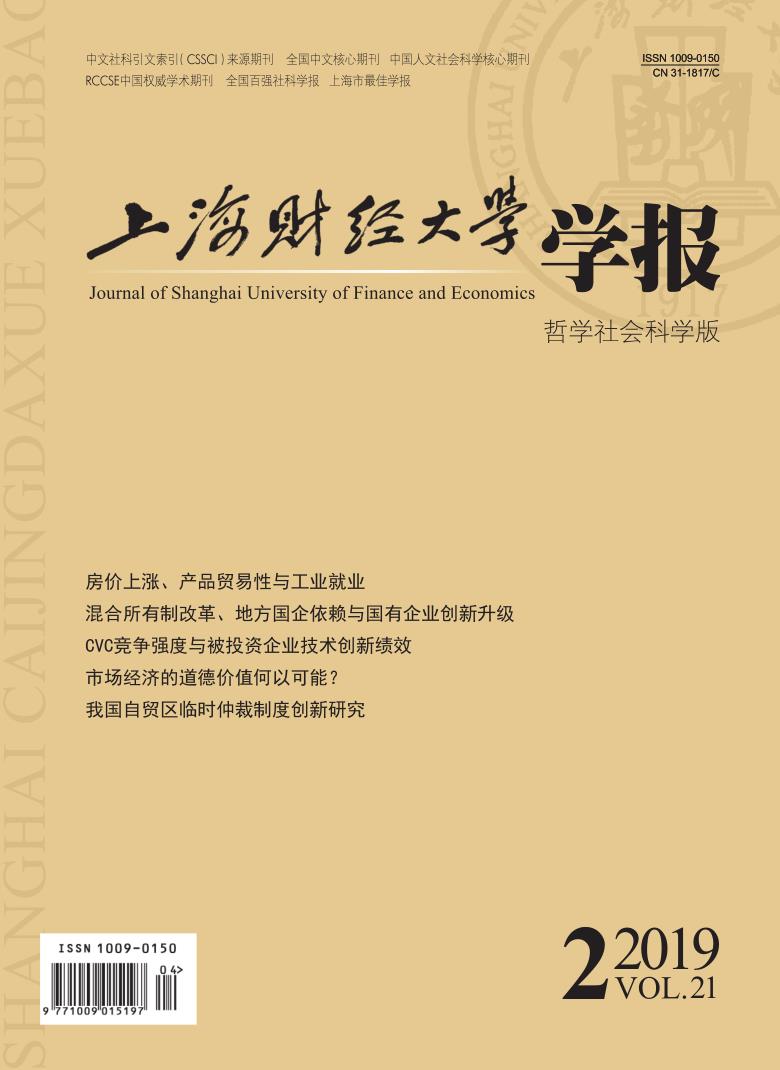退出率较高和持续时间较短一直是困扰中国企业出口的重要问题,不仅导致企业自身出口的低效率和不稳定,也有碍于我国出口的高质量发展。为了探寻两国(地区)的文化距离是否是这种高退出率和短持续时间现象产生的原因,文章利用GLOBE项目的调查数据将文化距离区分为文化现实距离和价值观距离,借助2000—2009年企业微观数据检验文化距离对中国企业出口持续性的影响及影响机制
文化距离对中国企业出口持续时间的影响——基于GLOBE项目的调查数据
摘要
参考文献
摘要
1 陈勇兵,李燕,周世民. 中国企业出口持续时间及其决定因素[J]. 经济研究,2012,(7). DOI:10.3969/j.issn.1004-7778.2012.07.015
3 刘慧,綦建红. " 邻居”对中国企业出口生存的影响有多大——基于信息溢出的视角[J]. 财贸经济,2018,(8). DOI:10.3969/j.issn.1005-913X.2018.08.046
5 温忠麟, 刘红云, 侯杰泰. 调节效应和中介效应分析[M]. 北京: 教育科学出版社, 2012.
7 周世民,孙瑾,陈勇兵. 中国企业出口生存率估计:2000–2005[J]. 财贸经济,2013,(2). DOI:10.3969/j.issn.1005-913X.2013.02.071
8 Agarwal R,Audretsch D B. Does entry size matter? The impact of the life cycle and technology on firm survival[J]. Journal of Industrial Economics,2001,49(1):21–43 DOI:10.1111/joie.2001.49.issue-1
9 Albornoz F,Fanelli S,Hallak J C. Survival in export markets[J]. Journal of International Economics,2016,102:262–281 DOI:10.1016/j.jinteco.2016.05.003
10 Araujo L,Mion G,Ornelas E. Institutions and export dynamics[J]. Journal of International Economics,2016,98:2–20 DOI:10.1016/j.jinteco.2015.08.004
11 Baron R M,Kenny D A. The moderator-mediator variable distinction in social psychological research:Conceptual,strategic,and statistical considerations[J]. Journal of Personality and Social Psychology,1986,51(6):1173–1182 DOI:10.1037/0022-3514.51.6.1173
12 Besedeš T,Prusa T J. Ins,outs,and the duration of trade[J]. Canadian Journal of Economics,2006a,39(1):266–295 DOI:10.1111/caje.2006.39.issue-1
13 Besedeš T,Prusa T J. Product differentiation and duration of US import trade[J]. Journal of International Economics,2006b,70(2):339–358 DOI:10.1016/j.jinteco.2005.12.005
14 Brenton P,Saborowski C,von Uexkull E. What explains the low survival rate of developing country export flows?[J]. The World Bank Economic Review,2010,24(3):474–499 DOI:10.1093/wber/lhq015
15 Cadot O,Carrère C,Strauss-Kahn V. OECD imports:Diversification of suppliers and quality search[J]. Review of World Economics,2014,150(1):1–24 DOI:10.1007/s10290-013-0172-3
16 Carrère C,Strauss-Kahn V. Export survival and the dynamics of experience[J]. Review of World Economics,2017,153(2):271–300 DOI:10.1007/s10290-017-0277-1
17 Córcoles D,Díaz-Mora C,Gandoy R. Export survival in global production chains[J]. The World Economy,2015,38(10):1526–1554 DOI:10.1111/twec.2015.38.issue-10
18 Eaton J, Eslava M, Jinkins D, et al. A search and learning model of export dynamics[R]. Meeting Papers 1535, 2015.
19 Elsass P M,Veiga J F. Acculturation in acquired organizations:A force-field perspective[J]. Human Relations,1994,47(4):431–453 DOI:10.1177/001872679404700404
20 Felbermayr G J,Toubal F. Cultural proximity and trade[J]. European Economic Review,2010,54(2):279–293 DOI:10.1016/j.euroecorev.2009.06.009
21 Fernandes A P,Tang H W. Learning to export from neighbors[J]. Journal of International Economics,2014,94(1):67–84 DOI:10.1016/j.jinteco.2014.06.003
22 Fu D H,Wu Y R. Export survival pattern and its determinants:An empirical study of Chinese manufacturing firms[J]. Asian-Pacific Economic Literature,2014,28(1):161–177 DOI:10.1111/apel.12050
23 Gokmen G. Clash of civilizations and the impact of cultural differences on trade[J]. Journal of Development Economics,2017,127:449–458 DOI:10.1016/j.jdeveco.2016.12.008
24 Guiso L,Sapienza P,Zingales L. Cultural biases in economic exchange?[J]. The Quarterly Journal of Economics,2009,124(3):1095–1131 DOI:10.1162/qjec.2009.124.3.1095
25 Hofstede G. Culture’s consequences: International differences in work-related values[M]. Beverly Hills: SAGE Publications, 1980.
26 House R J, Hanges P J, Javidan M, et al. Culture, leadership, and organizations[M]. Thousand Oaks, Calif.: SAGE Publications, 2004.
27 Hummels D L,Schaur G. Hedging price volatility using fast transport[J]. Journal of International Economics,2010,82(1):15–25 DOI:10.1016/j.jinteco.2010.05.002
28 Kabasakal H,Dastmalchian A,Karacay G,et al. Leadership and culture in the MENA region:An analysis of the GLOBE project[J]. Journal of World Business,2012,47(4):519–529 DOI:10.1016/j.jwb.2012.01.005
29 Kogut B,Singh H. The effect of national culture on the choice of entry mode[J]. Journal of International Business Studies,1988,19(3):411–432 DOI:10.1057/palgrave.jibs.8490394
30 Majune S A. Discrete time analysis of export duration in Kenya: 1995–2014[R]. MPRA paper No. 68727, 2016.
31 Melitz J. Language and foreign trade[J]. European Economic Review,2008,52(4):667–699 DOI:10.1016/j.euroecorev.2007.05.002
32 Melitz J,Toubal F. Native language,spoken language,translation and trade[J]. Journal of International Economics,2014,93(2):351–363 DOI:10.1016/j.jinteco.2014.04.004
33 Rauch J E. Networks versus markets in international trade[J]. Journal of International Economics,1999,48(1):7–35 DOI:10.1016/S0022-1996(98)00009-9
34 Rauch J E,Trindade V. Ethnic Chinese networks in international trade[J]. The Review of Economics and Statistics,2002,84(1):116–130 DOI:10.1162/003465302317331955
36 White R,Tadesse B. Cultural distance and the US immigrant-trade link[J]. The World Economy,2008,31(8):1078–1096 DOI:10.1111/twec.2008.31.issue-8
引用本文
刘慧, 綦建红. 文化距离对中国企业出口持续时间的影响——基于GLOBE项目的调查数据[J]. 上海财经大学学报, 2019, 21(2): 65-79.
导出参考文献,格式为:





 7866
7866  18374
18374

